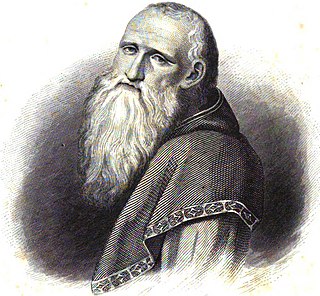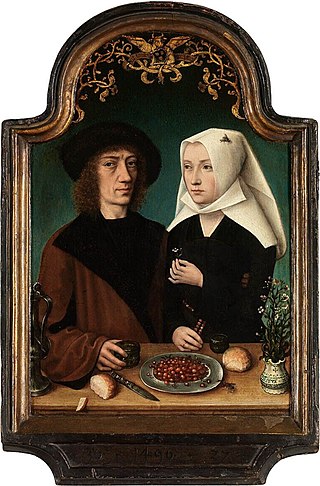
Oscar-Claude Monet was a French painter and founder of impressionist painting who is seen as a key precursor to modernism, especially in his attempts to paint nature as he perceived it. During his long career, he was the most consistent and prolific practitioner of impressionism's philosophy of expressing one's perceptions of nature, especially as applied to plein air (outdoor) landscape painting. The term "Impressionism" is derived from the title of his painting Impression, soleil levant, exhibited in 1874 initiated by Monet and his associates as an alternative to the Salon.

The Metropolitan Museum of Art, colloquially referred to as the Met, is an art museum in New York City. It is the largest art museum in the Americas and fourth-largest in the world.

Catherine of Alexandria, also spelled Katherine is, according to tradition, a Christian saint and virgin, who was martyred in the early fourth century at the hands of the emperor Maxentius. According to her hagiography, she was both a princess and a noted scholar who became a Christian around the age of 14, converted hundreds of people to Christianity and was martyred around the age of eighteen. More than 1,100 years after Catherine's martyrdom, Joan of Arc identified her as one of the saints who appeared to and counselled her.

The Cloisters, also known as the Met Cloisters, is a museum in the Washington Heights neighborhood of Upper Manhattan, New York City. The museum, situated in Fort Tryon Park, specializes in European medieval art and architecture, with a focus on the Romanesque and Gothic periods. Governed by the Metropolitan Museum of Art, it contains a large collection of medieval artworks shown in the architectural settings of French monasteries and abbeys. Its buildings are centered around four cloisters—the Cuxa, Saint-Guilhem, Bonnefont and Trie—that were acquired by American sculptor and art dealer George Grey Barnard in France before 1913, and moved to New York. Barnard's collection was bought for the museum by financier and philanthropist John D. Rockefeller Jr. Other major sources of objects were the collections of J. P. Morgan and Joseph Brummer.

Lorenzo Lotto was an Italian painter, draughtsman, and illustrator, traditionally placed in the Venetian school, though much of his career was spent in other north Italian cities. He painted mainly altarpieces, religious subjects and portraits. He was active during the High Renaissance and the first half of the Mannerist period, but his work maintained a generally similar High Renaissance style throughout his career, although his nervous and eccentric posings and distortions represented a transitional stage to the Florentine and Roman Mannerists.

Pietro Lorenzetti or Pietro Laurati was an Italian painter, active between c. 1306 and 1345. Together with his younger brother Ambrogio, he introduced naturalism into Sienese art. In their artistry and experiments with three-dimensional and spatial arrangements, the brothers foreshadowed the art of the Renaissance.

Francesco Francia, whose real name was Francesco Raibolini was an Italian painter, goldsmith, and medallist from Bologna, who was also director of the city mint.

Bernardino Luini was a north Italian painter from Leonardo's circle during the High Renaissance. Both Luini and Giovanni Antonio Boltraffio were said to have worked with Leonardo directly; he was described as having taken "as much from Leonardo as his native roots enabled him to comprehend". Consequently, many of his works were attributed to Leonardo. He was known especially for his graceful female figures with elongated eyes, called Luinesque by Vladimir Nabokov.

The Holy Family consists of the Child Jesus, the Virgin Mary and Saint Joseph. The subject became popular in art from the 1490s on, but veneration of the Holy Family was formally begun in the 17th century by Saint François de Laval, the first bishop of New France, who founded a confraternity.

Crusader art or the art of the Crusades, meaning primarily the art produced in Middle Eastern areas under Crusader control, spanned two artistic periods in Europe, the Romanesque and the Gothic, but in the Crusader kingdoms of the Levant the Gothic style barely appeared. The military crusaders themselves were mostly interested in artistic and development matters, or sophisticated in their taste, and much of their art was destroyed in the loss of their kingdoms so that only a few pieces survive today. Probably their most notable and influential artistic achievement was the Crusader castles, many of which achieve a stark, massive beauty. They developed the Byzantine methods of city-fortification for stand-alone castles far larger than any constructed before, either locally or in Europe.

Joos van Cleve was a leading painter active in Antwerp from his arrival there around 1511 until his death in 1540 or 1541. Within Dutch and Flemish Renaissance painting, he combines the traditional techniques of Early Netherlandish painting with influences of more contemporary Renaissance painting styles.

Giampietrino, probably Giovanni Pietro Rizzoli, was a north Italian painter of the Lombard school and Leonardo's circle, succinctly characterized by S. J. Freedberg as an "exploiter of Leonardo's repertory."

Bartolomeo Cavarozzi (1587–1625), occasionally referred to as Bartolomeo Crescenzi, was an Italian caravaggisti painter of the Baroque period. Cavarozzi's work began receiving increased admiration and appreciation from art historians in the last few decades of the 20th century, emerging as one of the more distinct and original followers of Caravaggio. He received training from Giovanni Battista Crescenzi in Rome and later traveled to Spain alongside his master for a few years where he achieved some renown and was significant in spreading "Caravaggism" to Spain before returning to Italy. His surviving works are predominantly Biblical subjects and still-life paintings, although older references note he "was esteemed a good painter especially of portraits".

The Master of Frankfurt was a Flemish Renaissance painter active in Antwerp between about 1480 and 1520. Although he probably never visited Frankfurt am Main, his name derives from two paintings commissioned from patrons in that city, the Holy Kinship in the Frankfurt Historical Museum and a Crucifixion in the Städel museum.

DenisCalvaert was an Antwerp-born Flemish painter who spent most of his life in Italy, where he was known as Dionisio Fiammingo or simply Il Fiammingo. Calvaert was a profound student of architecture, anatomy, and history. His works are characterized by their advanced composition and colouring.

The Mystic Marriage of St. Catherine is a c. 1480 oil-on-oak painting by the Early Netherlandish painter Hans Memling, now in the Metropolitan Museum of Art, New York. The Virgin Mary sits on a throne in a garden holding the Child Jesus in her lap. Mother and child are flanked by angels playing musical instruments, with St Catherine of Alexandria to the left opposite St Barbara on the right. The male figure standing slightly behind the celestial group, presumably commissioned the painting as a devotional donor portrait.

Self-Portrait as a Lute Player is one of many self-portrait paintings made by the Italian baroque artist Artemisia Gentileschi. It was created between 1615 and 1617 for the Medici family in Florence. Today, it hangs in the Wadsworth Atheneum Museum of Art, Hartford, Connecticut, US. It shows the artist posing as a lute player looking directly at the audience. The painting has symbolism in the headscarf and outfit that portray Gentileschi in a costume that resembles a Romani woman. Self-Portrait as a Lute Player has been interpreted as Gentileschi portraying herself as a knowledgeable musician, a self portrayal as a prostitute, and as a fictive expression of one aspect of her identity.

Holy Family with St Jerome and St Anne is a 1534 signed and dated oil-on-canvas painting by Italian artist Lorenzo Lotto, first recorded at the Palazzo Pitti at the start of the 18th century and now in the Uffizi in Florence.

Catherine of Alexandria is a tempera painting created by Ieremias Palladas. Palladas was a monk associated with Saint Catherine's sacred monastery in Egypt also known as Mount Sinai. He was a painter and teacher. His nephew became the Patriarch of Alexandria. His name was Gerasimos Palladas. Ieremias was a Sinaitic monk because of his association with Saint Catherine's monastery on Mount Sinai. The monastery encloses the site where it is assumed by Christians that Moses saw the burning bush. Ieremias was one of the most influential figures of his time. The Patriarch of Jerusalem Nectarius wrote about the painter in his archives.



















